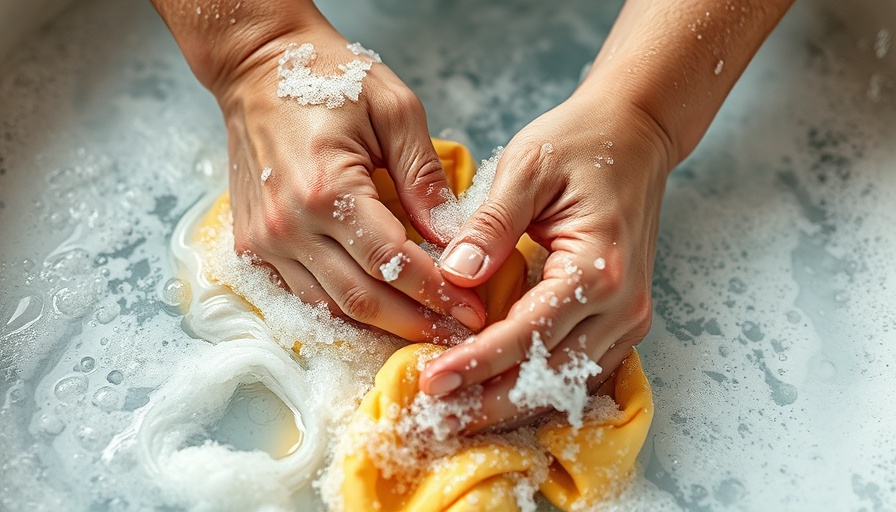
Understanding the Hype: What Is Laundry Stripping?
Laundry stripping is a popular deep-cleaning method that has gained traction over the past few years, particularly on social media platforms like TikTok. Initially perceived as a cleaning hack, this process aims to eliminate built-up residues from fabrics that can dull their brightness and affect their absorbency. Excess detergent, fabric softeners, hard water minerals, and even body oils can accumulate over time, especially in linens and towels.
Essentially, laundry stripping involves soaking items in hot, soapy water mixed with borax and washing soda—a method traced back to traditional cleaning practices but recently revitalized by digital influencers. Despite its viral success, it’s crucial to understand whether this method is truly effective and safe for all types of fabrics.
The Process: How to Strip Your Laundry Effectively
To successfully execute laundry stripping, you'll need the following ingredients:
Borax
Washing soda (sodium carbonate—not baking soda)
Standard laundry detergent
Here's a simple guide to conduct the process:
Fill a bathtub, sink, or bucket with hot water.
Add equal parts of borax and washing soda, with double the amount of laundry detergent. For a typical bathtub, this would mean ¼ cup borax, ¼ cup washing soda, and ½ cup laundry detergent.
Stir until all ingredients dissolve.
Submerge your clean fabric items (the best candidates are white or light-colored towels and sheets) into the mixture. Let them soak for at least four hours, occasionally stirring the mixture to maximize debris removal.
After soaking, drain the murky water and run your items through a complete wash cycle without detergent to rinse out any remaining residue. Tumble dry without dryer sheets.
What to Avoid When Laundry Stripping
While this cleaning method may work wonders for some items, it's essential to avoid specific fabrics that may not respond well.
**Colored Items**: Dye transfer is a risk when submerging colorful fabrics; the result can be a disastrous mix of colors. Stick to whites and colorfast items.
**Delicate Fabrics**: Items labeled for cold wash cycles may fade or shrink due to the high temperatures involved in stripping.
**Excessive Use**: Stripping should not be a routine practice; frequent washing and proper maintenance can often keep fabrics clean without this intensive method.
The Bottom Line: Is Laundry Stripping Worth Your Time?
The effectiveness of laundry stripping is hotly debated among cleaning enthusiasts. Some swear by its results, noting their fabrics feel just like new afterward. However, experts give a cautious nod to practicality. It’s important to remember that the likelihood of needing to strip mattresses and linens frequently could indicate improper washing techniques or too much detergent use in the first place.
Moreover, spending hours soaking items doesn’t fit into everyone's busy lifestyles. Instead, maintaining good laundry practices—like using the right amount of detergent, avoiding fabric softeners, and washing with hot water when appropriate—might give you the fresh laundry feel without the hassle of stripping.
Takeaway: Practical Tips for Laundry Maintenance
To sum it up, understanding laundry stripping is crucial if you seek a deeper clean for your linens and towels. Still, the most efficient solution might not come from viral trends but rather from adopting thoughtful laundry habits. Here are some helpful insights:
**Use Less Detergent**: Often, using too much detergent is counterproductive. Follow the recommended guidelines on the detergent packaging.
**Wash at Appropriate Temperatures**: Sometimes all that’s needed is to wash in hot water to release residual build-up effectively.
-
**Rotate Your Items**: Regularly rotate your linens and towels to ensure even wear-and-tear and freshness.
#LaundryStripping, #DeepCleaning, #CleaningHack, #TikTokTrends, #FabricCare, #Borax, #WashingSoda, #LaundryDetergent, #CleaningTips, #LaundryMaintenance
 Add Row
Add Row  Add
Add 




 Add Row
Add Row  Add
Add 


Write A Comment